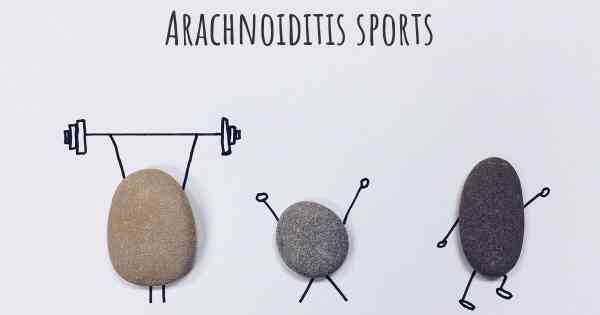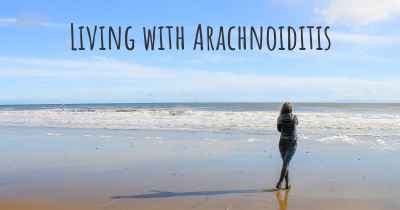Is it advisable to do exercise when affected by Arachnoiditis? Which activities would you suggest and how intense should they be?
See if it is advisable for people with Arachnoiditis to practice sports and which ones are the most recommended if you have Arachnoiditis

Arachnoiditis is a painful condition that affects the arachnoid, one of the membranes surrounding the spinal cord. It is characterized by inflammation and scarring of the arachnoid, which can lead to chronic pain, numbness, tingling, and even paralysis in severe cases.
When it comes to exercise and arachnoiditis, it is important to approach physical activity with caution. While exercise can have numerous benefits for overall health and well-being, it is crucial to choose activities that do not exacerbate the symptoms or worsen the condition.
Low-impact exercises are generally recommended for individuals with arachnoiditis. These activities help to minimize stress on the spine and reduce the risk of further damage. Some suitable exercises include:
- Walking: Walking is a low-impact exercise that can be easily modified to suit individual fitness levels. It helps improve cardiovascular health and maintain joint mobility without putting excessive strain on the spine.
- Swimming: Swimming and water aerobics are excellent choices for individuals with arachnoiditis. The buoyancy of water reduces the impact on the joints and provides resistance for muscle strengthening.
- Cycling: Stationary cycling or using a recumbent bike can be beneficial as it puts minimal stress on the spine while providing a good cardiovascular workout.
- Yoga: Gentle yoga poses and stretching exercises can help improve flexibility, reduce muscle tension, and promote relaxation. It is important to avoid any poses that involve excessive bending or twisting of the spine.
It is crucial to start any exercise program slowly and gradually increase the intensity and duration over time. Listening to your body and paying attention to any pain or discomfort is essential. If an activity causes increased pain or worsens symptoms, it should be discontinued.
Consulting with a healthcare professional is highly recommended before starting any exercise regimen, especially for individuals with arachnoiditis. They can provide personalized advice based on the severity of the condition and individual limitations.
In addition to exercise, pain management techniques such as heat or cold therapy, massage, and relaxation exercises can also be beneficial for individuals with arachnoiditis. These techniques can help alleviate pain and improve overall well-being.
Remember, every individual with arachnoiditis may have different limitations and responses to exercise. It is important to listen to your body, work within your comfort zone, and seek professional guidance to ensure a safe and effective exercise routine.
Getting in water helps because under water you are neutrality buoyant and it helps you to move easier. Over doing it will cause spasming and cramping. Hot tubs and heating pads work to help ease symptoms
Posted Apr 5, 2017 by Josh 2600
Posted Apr 7, 2017 by Barbara 1000
Posted Apr 11, 2017 by Kelly 5450
Posted May 18, 2019 by nancy 2500
Small weights to try to offset atrophy
- I also do Stretching Yoga, meditation daily as tolerated
Every person is different & each case should be evaluated & considered seperatly
Posted Jan 5, 2020 by Jcrandall72 2500
Posted Jan 5, 2020 by Deerut1963 2400
The movements need not to be large, but just as the guardsmen at Buckingham Palace have found, even just tightening the calf muscles and then relaxing them every few minutes can help reduce leg fatigue (the blood is pumped back up to the body by the muscles in the calf: if you don't contract these muscles, it tends to pool in the lower half of your body and this can lead not only to sore legs but also bad circulation to the feet and low blood pressure).
Shifting the weight from one foot to the other can help when standing in queues (a great British pastime!), but make sure you maintain a good upright posture so that you are not putting uneven strain on your spine and the muscles around it.
As Neville Shone* wrote in his book, "Coping Successfully with Pain", "Beware rest does not turn into rust."
(* Neville Shone was a university lecturer who had a full social life and keen interest in sporting activity until a spinal disease rendered him almost immobile. This and the constant pain forced him out of work and nearly led to complete despair. His book tells of the ways in which he managed to escape the prison of pain.)
He goes on to clearly state "PROLONGED INACTIVITY PRODUCES DISABILITY"
Note that arachnoiditis is an inflammatory condition and should be approached in a similar fashion to conditions such as rheumatoid arthritis: the adage "No pain, no gain" DOES NOT apply.
However, it is vital to maintain the highest mobility possible within the confines of your individual physical condition, in order to reduce a domino effect of musculoskeletal problems and of course, osteoporosis which can result from immobility. In addition, loss of mobility can be very damaging to morale.
"Use it or lose it" is unfortunately a very true adage: lack of exercise leads to loss of muscle strength and it takes at least 10 times as long to replace as it does to lose it.
Recent studies have suggested that a moderate amount of exercise can actually help to reduce pain for a short period: 25 minutes on a cycle ergometer reduced pain perception 5 minutes most-exercise and this lasted for 30 minutes.
However, if pain increases, it must be remembered that aggravated neuropathic pain may well exacerbate any sympathetic dysfunction you have: therefore blood pressure, pulse, heat intolerance and sweating may be affected and this can last well after cessation of the exercise.
There may not be an immediate increase in pain; you may find that you have more pain later or after several exercise sessions, a flare-up may occur. It is therefore extremely difficult to gauge the level of exercise that you can tolerate.
It is best to start slow and only increase the level or frequency of exercise after 4-6 weeks of sustained exercise without adverse effects. Several short stints interspersed with rests are better than one long go.
Some of the exercise options: (most important ones starred)
(i) *Hydrotherapy: a warm pool is essential to prevent muscle spasm from cold; too hot a pool may exacerbate symptoms as arachnoiditis patients tend to suffer from heat intolerance in a similar way to MS patients.
(ii) *Swimming: well known to be an excellent way of getting some exercise; try to use a pool with warm water as if it is too cool, you may find your muscles tense up and you get little benefit.
In much the same way as other patients with back problems, arachnoiditis patients need to avoid movements that put strain on the back: butterfly, breast-stroke and backstroke may hyperextend the spine.
However, backstroke is the best stroke type for those who suffer from neck pain (you may be able to gently float and move slowly by kicking the legs, using the arms to maintain the float rather than use the full arm movements used in proper backstroke).
Sidestroke is good for strengthening the abdominal muscles and is also relatively easy on the neck (breast-stroke is particularly stressful on the neck, especially if the swimmer is attempting to keep the whole head out of the water at all times).
(iii) Isometric exercises: minimum resistance to movement (cf. Weight lifting) a careful regime may help to improve muscle strength in problem areas.
(iv) Aerobic exercising: good for cardiovascular system and may help to counteract poor circulation: but many arachnoiditis patients will not be able to manage this type of exercise.
(v) *Range of movement exercises (ROM): as recommended for sufferers of conditions such as rheumatoid arthritis: moving joints through their anatomical range (not against resistance) helps to maintain mobility.
(vi) *Pelvic floor exercises: used in rehabilitation of patients in spinal cord injuries, MS and post-partum (childbirth) urinary problems.
(vii) Pilates: this is the new "in thing" in exercise but most of the arachnoiditis patients I have spoken to who have tried the technique have found it too strenuous.
(viii) Feldenkrais: awareness of the body through movement: it systemically refines the process by which toddlers learn to walk. It is done either in a group or as an individual. The patient can move at his/her own pace appropriate for his/her condition.
The emphasis is on awareness of the body, learning to sense changes or differences, aiming to eliminate excess effort and inefficient habits and find more comfortable and effective alternatives. Individual sessions last 30-60 minutes; the patient sits/lies on a low padded table and the practitioner moves the patient slowly: turning the head or lifting an arm or leg gently.
These may be large or small movements. Patients in studies of Feldenkrais report decrease in pain, increased ability to do daily activities, reduced anxiety and depression and less need for visits to the doctor.
(ix) T'ai chi is another modality, which will help: again, there is emphasis on the quality of slow movements. It involves flowing movements combined with relaxation and meditation techniques. Each movement is fairly easy to perform, and may help to re-establish good balance and flexibility. Some Pain management courses teach this therapy.
(x) Qigong: based on the principles of Taoism (the ancient religion/philosophy of China) this focuses on feeling and moving energy within the body through a series of gentle, sometimes virtually static, exercises. It is thought to be the precursor to T'ai chi.
It is vital to tailor the exercise regime for each individual patient. It may be extremely difficult to gauge the limits, as an increase in pain does not necessarily occur during the exercise period, but may in fact arise hours of even days after the exercise (or there may be a cumulative effect some days later: which tends to trigger a "flare-up").
During "flare-ups", it is advisable to reduce the exercise and revert to a minimal regime aimed at helping to decrease pain in muscles/joints.
Posted Jan 5, 2020 by Staplehurst17 4050
Posted Jul 9, 2020 by Derek 3000
Posted Mar 20, 2021 by Anna 2300
Try not to overdo it.
Posted Jul 22, 2021 by Vincent 3420
Posted Nov 15, 2021 by ACMCRN 2200
Posted Nov 16, 2021 by [email protected] 700
Do not bend or lift or anything that will increase your pain. Listen to your body. Push yourself to do what you can.
Posted Jan 7, 2022 by Machinetoolmkr 5550








